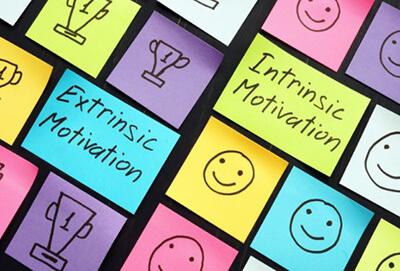Navigating the classroom has its unique set of challenges, especially in the realm of student motivation. And I experienced this pretty much in the first year of being a teacher. Having shifted from the corporate world into student education, I was green about large-sized classroom management strategies, but not so green about learner-motivation. That’s because I was dealing with my young son at home and figuring out tricks, through varied trials & hits, as well as by reading up books like “How Children Learn.”

A clear indicator of diminished motivation is when students start chatting individually, resembling scattered kernels of corn. Before long, my class resembled a bowl of loudly popping corn from random chairs, with little focus on the task at hand. Initially, this would get me down with a twisted feeling in the gut that I had failed! And I couldn’t fathom why! I felt, my lesson plans were fairly creative; my add-on resources were good, activities and assessments were well -planned….so what was going wrong?
My biggest error, I realised, stemmed from “I felt…”. Reality hit! It wasn’t about ME and what I felt; rather it was about what my bunch of learners felt! What THEY found interesting or not, or felt motivated to sustain as an activity for learning.

Other educators shared that they too were able to reach many of their students, but there were those who were quite unreachable. No matter what they tried, such kids had no interest in learning, no interest in doing quality work, and most teachers were quite out of ideas, letting the day roll by till the next bell rang for a relieving change of class! I had my own set of unmotivated students, and I hadn’t discovered any magic potion for my lot. Thankfully, I wasn’t the only one facing this challenge.
For a long time, I had no solutions; the problem was really complex. So, I decided to do some research, to try to find what the most current studies said about what motivated students. This is what I found:
- Students are more motivated for academics when they enjoy a comfortable and positive relationship with their teacher.
- Choice can be a powerful motivator – making room for offering choices works splendidly for upping motivation in most educational contexts.
- For complex tasks that require creativity and persistence, extrinsic rewards and consequences actually hamper motivation.
- To stay motivated to persist at any task, the learner must believe that s/he can improve in that task.
What I read was out there on the Internet, free for all to read, learn from, try out as strategies, and attain success, right? If we as a collective group of educators had access to all this material, as well as the tips to motivate students, why were so many students still unmotivated?

While discussing with my colleagues, about the problem, I found I was getting drawn into staffroom discussions hovering over convenient blame games… of blaming (a) technology: “Students are so distracted by their digital gadgets,” OR blaming (b) the parents: “Parents are just not bothered” or “Parents protect their kids too much – they don’t want their kids to fail/experience setbacks/take responsibility,” OR making (c) sweeping generalizations: “Kids today just aren’t like what we used to be. Today’s kids behave as if they have no care in the world, they behave so entitled.”
I had to stop in my tracks. What were we doing? Passing the buck? Maybe. It was certainly easier to blame outside forces than it was to look inward and make big changes in the way we taught. Unfortunately, even if ALL of the above statements were true, they weren’t within our circle of influence; and we couldn’t do anything about them. The only thing we really had control over is WHAT went on in our own classrooms.
It was time to look at my own practice.
I set aside all the outside factors and just focussed-in on my time with my students….how was I doing? How much alignment was there between my own instructional moves and the research on student motivation? After the period of research, reflection, review and realignment, I summarised my analysis into 5 questions that educators facing student-motivation problems should ask themselves, to see if they really were doing everything they could possibly do, to boost student motivation.
Without getting too preachy, I’ll run through those 5 questions based on the 4 above-mentioned findings with you, reflecting on the years when I was a teacher with preparatory & middle school students.
Review 1 : How was my relationship (really), with my students?
A respectful, yet comfortable teacher-student relationship provides students with a sense of stability and safety, which sets the stage for more academic risk-taking and building the inner drive to do something.

- So, what kind of relationship did I have with my least motivated students?
- How well did I really know them?
- Did I have conversations with them about the things they cared about?
- Or was I more or less giving up on them?
My honest reply to myself
I mainly taught English language & Social Science and my students were by and large very regular with their tasks, so I got to know them well. But when I think about my less-motivated kids, I’m not so sure I could say the same. The connection I had with Sohail* consisted entirely of my getting him to make up missed work, write neatly and scolding him for disrupting the class. That was all we talked about: the missing work, why he wasn’t turning it in, how important this stuff was for his future . . . blah – blah – blah. When Sohail saw me coming, he probably just saw a dark looming cloud of nag! We never really talked about the stuff that mattered to him.

I’d like to add here that as a fairly alert and passionate educator, I NEVER gave up on any child. A child who is already unmotivated feels insecure, is probably not doing too well academically (and sadly for some), also bearing the brunt of class ridicule, wrapped in the feeling that he is incapable of achieving anything. If teachers give up on such children, they reinforce that feeling and the child will never be motivated to make any attempt or put in any effort to improve.
The child probably feels that – “Staying at the lowest of low level is ‘safe’ – one can’t fall lower than that, can one? And if I put in efforts to move up one level, oh my god! More effort to stay there and not fall!”
What I learned to do better

I became more aware of the value of my relationship with students, beyond just academic demands. Student to student relationships mattered too! Fun quizzes, new Did-U-Know GK facts out my hat, or a funny retell of a hilarious experience from the previous day, built an immediate ‘whole community-like’ motivation to know about the unknown, at times with awe and at times with humour.
The disconnect gradually melted away into a connect that also taught me how to learn to laugh at myself! I was also guided by a senior mentor to go through some videos on YouTube and other academic pages that really helped (try them – you might find something that works for you):
- the 2 x 10 strategy, shared by Angela Watson – in which teachers spend two minutes a day for ten days casually chatting with underperforming students.
- Smokey and Elaine Daniels’ The Best-Kept Teaching Secret – which talks about how dialogue journals can help educators to get to know their students better, personally and academically
- Jim Sturtevant’s book, You’ve Gotta Connect – which helped me a lot and is full of specific strategies for building stronger bonds with one’s students.
Review 2 : How much CHOICE did my students actually have?

I mentioned earlier about CHOICE being a great motivator. We hear this stated often times in education circles, but very few of us actually embrace it. After all, providing choice can be messy, with students completing different tasks at different paces, making it hard to be consistent with grading. It can also mean a lot more preparation and planning for us teachers!
Think about it – if you were to give students three different options for an assignment, that means you would have to prepare all three options ahead of time. Or would you? Isn’t it easier planning for worksheet-oriented teaching, where students are doing low-level ‘assured correct answer’ work that was largely prepared by the teacher? However, if students are to be engaged in more long-term, authentic, creative projects, it’s would be more meaningful and motivating for them to be provided with choices!
My honest reply to myself
I was actually quite open and free with letting students choose topics for assignments or the type of model material to use for projects or the demo experiment they wished to perform in front of the class to exhibit their performance of understanding. But when I start thinking about Jaydev* or Abhinav* (who, by the way, were incredibly smart, but unmotivated), I realised I had minimal success. The “dark looming cloud of nag” approach I used with Sohail also failed miserably with these two.
I didn’t realise then the power of differentiation for learners and the power of choice!
What I learned to do better
I realised I could have handled things better – perhaps, had a conversation with Jaydev about letting him work ahead with somethings; or given Abhinav and his project mates guidance on more individual-centric tasks. If I had identified how they could have had a more active role in their own learning based on their area of interest, they may have been more participative and engaged; rather than sitting way low in their chairs constructing projectile games with their pens!

I also learned from discussion with others and personal reading that there were a lot of ways to allow more choice in the classroom without having to upset the boat or having to go against the grain of school rules and norms. These included allowing choices for – seating, project groups, type of resource for learning (reading or audio book or video), type of task submission (make a podcast, video record the presentation, beautify a journal rather than a standard notebook answer), and even timing (allowing students to change the order of activities and timelines as long as the final submissions fall within the deadline).
Review 3 : How much was I relying on the carrot ‘n stick approach?
Many teachers, even today, rely on rewards (carrots) and punishments (sticks) to get work completed, thinking they have motivated the students. Wrong! Students held to ransom by the ‘sticks’ complete tasks out of fear, not because they were genuinely motivated and wanted to.

Extrinsic reinforcement can work for simple and easy tasks (like getting students to clean up the classroom quickly, in exchange for a PE period). But for tasks that require critical thinking, creativity and complex thought, extrinsic rewards actually reduce motivation.
Think about these Qs (as I did when I was on Review 3):
- In the class, how much of your motivational approach is extrinsic?
- How often do you use grades, treats, privileges or punishments to prod students into doing something they don’t really want to do, something they have no real interest in?
Know that, if extrinsic reinforcement is your primary approach, you may actually be killing off any natural motivation students might have otherwise had.
My honest reply to myself
I scored a pathetic low on this one! As a teacher, my classroom management ability in the beginning was quite a mess – I found the supposed magic wand of controlling students with names on the board, extra credit, whole-class rewards for good behaviour, and the ever-reliable promise of bringing in my special Pasta in Pink Sauce on the next working Saturday!
I admit now that those were not good practices at all – I did those because they worked for me! But there’s a difference between getting kids to do what I want and truly, deeply motivating them to perform and participate by their own initiative.
What I learned to do better

I made a conscious effort to catch myself the subsequent times I was tempted to tie a challenging activity to a reward or a punishment! I prepared for my class lessons well, ensuring that when introducing a task, I tried to focus on its inherent interest or value and how much students would learn rather than earn as a grade or a star.
I tried to devise methods clubbing choice with mild rewards, like:
- “Well, here are 20 words for the forthcoming Dictation Test from Chapter 5. However, I propose to give one extra word from the lesson that is not in this list of 20. If you get that spelling correct, you can offset it against an incorrect spelling. AND, if you get all 20+1 correct, then you get triple stars!”
- “Here are 8 questions that I would like you attempt; the first 6 are compulsory for all, and the last 2 are for extra credit.”
- I had to use a different approach for the same objective for my senior class (even if you label me an unfair tease). It worked wonders!
“Hey class, here are 8 questions of which the first 8 are really easy. But I want to see how many of you can do those last 2? Aha! Frankly, you have acquired much more knowledge than these require and I believe you can attempt ALL the Qs…anyway, let’s see!”
The first two approaches are clear-cut and an easy win, the extrinsic reinforcement to earn if they make that extra effort. However, for the underperforming, unmotivated students, try moving more toward the second approach and see if anything changes. Some kids love being challenged; they love competition.
Review 4 : Was my communication with students aligned to a ‘growth’ mindset or a ‘fixed’ mindset?
This question was directly linked to my 4th finding that “Students are motivated to persist at a challenging task when they believe they can get better at it”. That requires them to have a growth mindset, i.e. the belief that their intelligence and abilities can be developed with effort.

Teachers have a direct impact on this mindset with what they say to students and how they respond to misses and failures. By saying something like – “You’re so smart,” “You are gifted in Math,” or “You’re a born writer,” we are telling the student that it is their natural ability that got them where they are. We’re actually contributing to a fixed mindset; almost as if to say – they cannot develop anything else or in any other sphere, other than what they are currently showing prowess in. That’s certainly NOT motivating.
My honest reply to myself
I can hide behind the convenient excuse that, back when I was a teacher in the classroom, no one discussed anything about ‘growth mindset’. I thought my students would feel great if I told them they were smart or talented.
I can remember a conversation with Raviraj*, a student who commanded the attention of his peers with ease, but got into trouble a lot and fared poorly in academics. I remember pulling him aside and telling him that I thought he had strong leadership qualities, and that if he could just get his grades up, he had a bright future ahead of him.
Of course, that didn’t work! If I wanted him to “get his grades up,” I would have been better off noticing a well-constructed sentence or complimenting the way he got his garba dance group back on track during a cooperative learning activity or how he deftly manoeuvred the football during the inter-house match, showing him, exactly what kind of choices he should keep making to be successful.
What I learned to do better
What I learned over time was:
- Instead of praising something innate and fixed about a student, I should focus on specific things students can actually control. So instead of :
- telling a student she’s a smart / great student, I needed to observe the level of detail in her answer;
 just saying “Well done!” to another student, I should be marvelling at the level of difficulty s/he was able to handle on that challenging problem of calculating time between cities, based on their latitude;
just saying “Well done!” to another student, I should be marvelling at the level of difficulty s/he was able to handle on that challenging problem of calculating time between cities, based on their latitude;- generically saying “Wow! Awesome project!”, I should point out and commend how much preparation each team member must have done for the presentation they gave on ‘Minars and Minarets’.
It’s always faster and easier to just tell students that they’re awesome, but taking the time to be specific and focus on their individual special efforts will pay much larger dividends towards improving motivation.
- When I had formulated the constructive feedback to be given, I needed to follow the exact same principle of making it specific. Rather than saying “you need to work harder”, I needed to be specific in guiding a student on exactly what to work on and which areas needed deeper reading and practice. I started focussing on things like – Is neatness in mapwork an issue with this child? Does she need to read the questions more slowly? Is he doing the short answers right, but messing up with the flow and structure of the long answers?
If a student knows what to work on and how, s/he will be far more motivated to do that work.
Review 5 : Was I making the academic content relevant to my students’ lives?

This is a question I found most teachers answering in the affirmative – “Of course, I give lots of real-life examples.” In my opinion, this principle has been around for a long time and we assume we’re making the connection more than we are actually doing it in class!
So, how was I doing in this aspect? Did I regularly provide opportunities for students to connect what they were learning to the world they lived in?
My honest reply to myself
To be honest, along with managing the school (as the Head) and actively teaching across many grades, I got a little lax about this. Just like taking time to think of a good opening and closing for each day’s learning, I ended up often cutting corners on making the content and study material always relevant. Initially, I was often much more focused on getting through content and tasks than I was on making learning meaningful.
Having said that, I must admit that I was pretty good at designing written assignments on topics that they would need to research on and they would find interesting, but I wasn’t paying heed to whether I was connecting what they were doing to how it could help them in life. For example, with something like letter-writing, I was probably more focused on “this is how you get a good grade on this” rather than on “this is how you can use letters to narrate an experience” or “put forth a complaint for your society or” change someone’s mind with your perspective.”
What I learned to do better
What I learned over time allowed me to consciously focus on 3 aspects:
- Planning and remembering to highlight the relevance at an appropriate point
- Making students reflect on how the concept connected with their individual lives
- Designing activities and projects, that made students apply their learning in the real-life societal scenario
- Planning and highlighting the relevance: Making material more relevant can be as simple as occasionally stopping an activity to explain its relevance. E.g. when studying bacteria, talk about all the places bacteria hang out in students’ daily lives. Making these kinds of connections is a natural practice for many teachers, but if you’re anything like ‘ME before my awakening’, you might forget to add these connections into a lesson. So do what I used to do – just boldly add them into your lesson plan or literally pencil them down in the textbook near the appropriate paragraph; then check at the end of class whether you covered them.
-
Make Students reflect: Asking students by turn, to think about how course material connects to their own lives can make a difference in motivating them to think, speak up and find connections. And here’s the beauty of this approach – when you consistently get children to make connections to what they are learning, over time it just becomes a habit! When they learn something new, almost as a reflex, they start making own-life connections or finding similar situations that they can relate to. Now THAT’s a life skill they will need for life!
One of the resources I had read exemplified a teacher asking her students to write weekly reflections on how the learning and concepts covered in that week related to their lives. Strangely, lower-performing students in these classes did better compared to those where teachers didn’t use this intervention. Researchers referred to these as “value interventions.”

Design tasks that can be applied to society: Many schools that follow project-based learning (PBL) or actively participate in events like Design For Change – I CAN challenge; consciously encourage student projects that have an authentic, public end product—like a video, a live presentation, a community service project, a website—something that will ultimately be consumed by people outside of their own classroom. This naturally motivates students to work harder on a task.
So, I redesigned my plans to ensure that each big concept was wrapped around ways to build assignments connected with real, public issues, products, services.

So, that was my journey of evolving from a mediocre teacher struggling with student motivation, to emerging as one, who my students wanted more time with! The purpose of this exercise is not to beat ourselves up. It’s just a way of deeply analysing and diagnosing a problem most teachers struggle with. There’s a very good chance that the easy blame-points of technology, parents, or entitlement are playing a role in what we perceive to be reduced student motivation. But there’s a very good chance that our own instructional decisions play a role as well.
So, if you are struggling with student motivation (as I did years ago), then pick one area from above and start there. Make a small adjustment every 15 days and see what happens. Remember, for solving a problem as complex as student motivation, there is no 2-minute Maggi-magic formula nor a Druid potion. Instead, we need to identify a set of tools that we blend and refine over time. The process will definitely be slower and more frustrating than a single, easy solution, but hey, we are all educational professionals who are lifelong learners, aren’t we? This is our craft, what we do best. And I know, if I could change, so can you! Good Luck!
*The names of the students in my testimony have been changed to preserve their identity.


